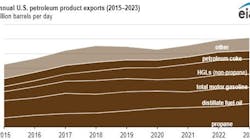Nick Snow
Washington Correspondent
WASHINGTON, DC, Oct. 17 -- US refiners spent $8 billion, and pipelines and terminal operators spent hundreds of millions more to bring ultralow-sulfur diesel (ULSD) to market, an official of the American Petroleum Institute said at the group's annual meeting here.
As of Oct. 15, the sulfur content of 80% of highway diesel sold in the US could not exceed 15 ppm, compared with 500 ppm previously. All but the smallest refiners had to start making ULSD in June. Some of them are processing to well below the specified level to offset contamination by residual sulfur in distribution systems.
Alfonse Mannato, fuels issues manager in API's downstream department, reported the spending estimates and said, "We were nervous about the rollout of this program. It's going smoothly. We haven't seen problems in supplies or vehicle performance."
He and John Felmy, API chief economist, said availability of the new product exceeds 80% of highway diesel.
"We're not out of the woods yet. But we haven't heard of any major problems," Felmy said.
At API's meeting, US Environmental Protection Agency Administrator Stephen L. Johnson called the transition to ULSD "the single biggest achievement since the removal of lead from gasoline 25 years ago."
California's deadline for availability of ULSD was Sept. 1, but EPA gave the industry outside that state an extra 45 days to address contamination and other potential transportation problems.
Tackling contamination
Mannato pointed out that some refiners are producing diesel with 7-8 ppm sulfur "so it will be at the specified level by the time it travels through two or three pipelines."
EPA set the availability deadline for the new fuel to accommodate exhaust-treatment systems on diesel engines starting with the 2007 model year.
"Right now, our diesel fuel is the cleanest in the world. Europe has a 10 ppm diesel, but it's not across the board. Much of what is sold there is still 50 ppm," Mannato said.
Current diesel engines will run cleaner on ULSD, but the emissions reduction won't be as dramatic as when the highway diesel transportation fleet fully turns over in 25-30 years, he said.
This will provide time for the oil and transportation industries to solve any operational problems, Mannato continued. Inadvertently mixing ULSD with low-sulfur diesel in vehicles' fuel tanks could clog fuel filters, so truckers and other operators have been alerted to report problems, he said. Additives at terminals will compensate for lubricity losses caused by sulfur removal.
Mannato said the transition to ULSD may have been more dramatic than the move to unleaded gasoline because the latter was accomplished over several years; ULSD came to the market within a few months.
Felmy said, "I was a little concerned in late May when the production figures for ULSD had not grown very much. Then they started to climb during June, and I felt better."
Contact Nick Snow at [email protected].
